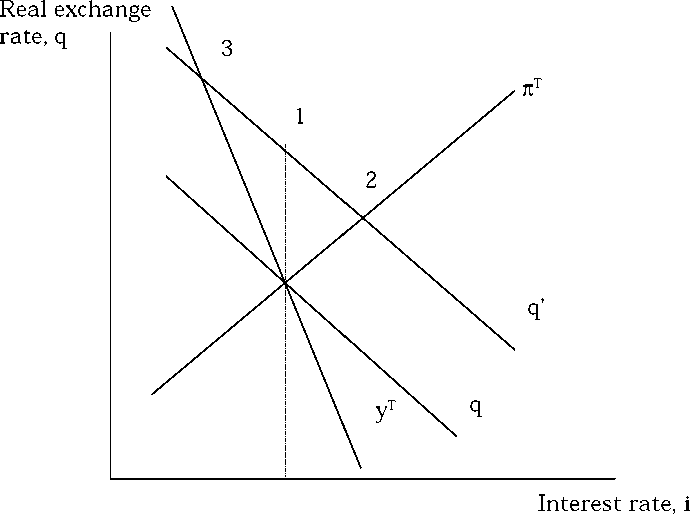The Interest Rate-Exchange Rate Link in the Mexican Float
Figure 3. Output and inflation targets under contractionary
depreciation.

the rate of nominal currency depreciation (given that the inflation
rate will be increasing). But the higher depreciation rate will take
place in a context of falling interest rates. Both factors tend to depress
the return on peso investments, as shown by Equation (1). If private
agents are able to foresee this path, they will reduce their demand for
peso assets as they try to shift to dollar assets. This fall in the demand
for peso assets will make it difficult to follow an anti-cyclical policy. In
contrast, choosing a tighter policy stance after the capital account shock
will yield a declining rate of currency depreciation together with higher
interest rates. This combination will tend to stabilize the demand for
peso assets, which may be particularly important in the aftermath of
the shock (a point stressed by Carstens and Werner 1999, pp. 44, 47).
Perhaps it is important to clarify that this result does not depend
on the assumption that a currency depreciation has a negative output
effect, but only that output falls after a negative capital account shock
(for instance, because of the effect on financial aggregates following a
23
More intriguing information
1. The Effects of Attendance on Academic Performance: Panel Data Evidence for Introductory Microeconomics2. The Structure Performance Hypothesis and The Efficient Structure Performance Hypothesis-Revisited: The Case of Agribusiness Commodity and Food Products Truck Carriers in the South
3. Estimating the Impact of Medication on Diabetics' Diet and Lifestyle Choices
4. Examining the Regional Aspect of Foreign Direct Investment to Developing Countries
5. The name is absent
6. Climate change, mitigation and adaptation: the case of the Murray–Darling Basin in Australia
7. Innovation Policy and the Economy, Volume 11
8. How Offshoring Can Affect the Industries’ Skill Composition
9. Business Cycle Dynamics of a New Keynesian Overlapping Generations Model with Progressive Income Taxation
10. Survey of Literature on Covered and Uncovered Interest Parities